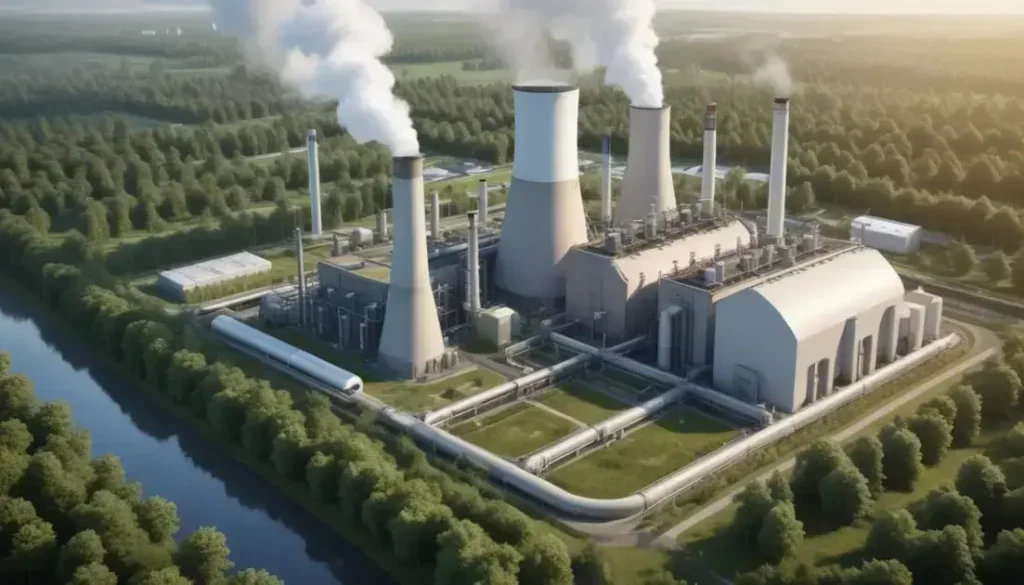Carbon capture technology, including Direct Air Capture and nature-based solutions, is essential for mitigating climate change by efficiently removing CO2 from the atmosphere and promoting environmental sustainability through innovative practices.
Welcome to a deep dive on carbon removal technologies, focusing on Climeworks’ innovative approaches. How can these solutions shape the future for Indian businesses?
Overview of Climeworks
Climeworks is a pioneer in the field of carbon removal technology, focusing on Direct Air Capture (DAC) to combat climate change effectively. Founded in Switzerland, the company has been at the forefront of innovation in removing carbon dioxide from the atmosphere. The DAC technology they utilize draws in air through specialized filters, which then capture carbon dioxide, allowing for its permanent storage or utilization in various applications.
One key aspect of Climeworks’ solutions is their scalability. The company aims to ramp up production rapidly to meet global carbon removal targets, which are essential for limiting global warming. Climeworks plans to establish large-scale plants that can absorb significant quantities of CO2 from the air, contributing to climate mitigation efforts worldwide.
An essential part of the Climeworks model is the commitment to transparency and sustainability. Their operations are powered by renewable energy, ensuring that the process of carbon removal does not contribute further to emissions. Moreover, Climeworks encourages businesses to invest in carbon removal as a proactive step towards achieving corporate sustainability goals.
Importance of carbon removal
Carbon removal plays a critical role in addressing climate change by directly reducing the amount of carbon dioxide in the atmosphere. This process is essential for achieving global climate targets, which aim to limit temperature increases to well below 2 degrees Celsius. As countries commit to reducing their carbon footprints, the importance of technological advances in carbon removal becomes even more pronounced.
The significance of carbon removal lies not only in mitigating climate change but also in enabling industries to transition towards net-zero emissions. Companies are increasingly recognizing the need to invest in sustainable practices and technologies that can effectively remove CO2. This shift presents opportunities for innovation and economic growth, showing that sustainability and profitability can go hand in hand.
Furthermore, integrating carbon removal strategies into business models enhances brand reputation and engages environmentally conscious consumers. By supporting carbon capture technologies, industries can demonstrate their commitment to sustainability, creating trust and loyalty among stakeholders. As we advance, prioritizing carbon removal initiatives will be crucial for ensuring a resilient and sustainable future.
Direct Air Capture explained
Direct Air Capture (DAC) is a pioneering technology designed to remove carbon dioxide directly from the atmosphere. This innovative approach utilizes large fans to draw in ambient air, which then passes through a series of filters or chemical processes that capture the CO2 molecules. The captured carbon can either be stored underground safely or repurposed for commercial uses such as creating synthetic fuels or enhancing plant growth.
The efficiency of DAC systems is increasingly important in the fight against climate change. As global temperatures rise, the need to balance emissions with removal becomes critical. DAC technologies are designed to scale up and process large volumes of air, making them vital for achieving net-zero emissions across various sectors.
Moreover, one of the notable advantages of DAC is its flexibility. It can be deployed anywhere, whether in urban areas or remote locations, utilizing renewable energy sources to minimize the carbon footprint of its operations. This adaptability allows for broader implementation, enhancing the prospects of meeting international climate targets. As DAC continues to evolve, it holds promise for altering the landscape of climate action and supporting industries in their transition to lower carbon outputs.
Climeworks’ funding milestones
Climeworks has achieved significant funding milestones that underscore its leadership in the carbon removal industry. These investments are crucial for scaling up their Direct Air Capture technology, enabling the company to build larger facilities and enhance its carbon removal capacity. With backing from prominent investors, Climeworks aims to capture millions of tonnes of CO2.
In recent funding rounds, Climeworks has successfully attracted attention from both venture capitalists and sustainability-focused funds. This influx of capital not only supports technological advancements but also facilitates strategic partnerships with other key players in the environmental sector. The funds are directed towards expanding operational capabilities and advancing research into more efficient carbon capture techniques.
Furthermore, Climeworks’ financial growth reflects increasing global awareness and demand for carbon removal solutions. As businesses and governments prioritize sustainability, the investment landscape for technologies like DAC is becoming more vibrant. With the right funding, Climeworks is setting the stage for transformative impact in the fight against climate change and aims to position itself as a go-to solution for industries looking to reduce their carbon footprints.
Key partnerships with firms
Climeworks has strategically established key partnerships with various firms to enhance its carbon removal capabilities and broaden its impact. Collaborations with major companies in the tech and energy sectors have provided Climeworks access to innovative technologies and additional funding, crucial for developing and deploying their Direct Air Capture systems.
These partnerships are not merely financial; they are also geared towards fostering innovation. For instance, collaborating with renewable energy companies ensures that Climeworks’ operations are powered sustainably, thus minimizing the overall carbon footprint of their carbon capture processes. This alignment with other sustainability-oriented enterprises enhances both credibility and efficiency.
Additionally, partnerships with academic institutions play a vital role in advancing research and developing new methods for capturing carbon. By leveraging expertise from various domains, Climeworks can continuously improve its technologies, ensuring alignment with evolving environmental standards and consumer expectations. These collaborations create a robust ecosystem for environmental innovation, making carbon removal more viable and scalable.
The role of SAP and TikTok
The collaboration between Climeworks and major companies like SAP and TikTok highlights the vital role of corporate involvement in advancing carbon removal technologies. SAP, a leader in enterprise software, has embraced sustainability and led initiatives to address climate change, supporting Climeworks through investment and strategic insights. This partnership leverages SAP’s expertise in data management to enhance Climeworks’ operational efficiency.
On the other hand, TikTok’s involvement exemplifies how social media platforms can contribute to environmental efforts. By utilizing its vast reach, TikTok aids in raising awareness about carbon removal and climate action. The platform’s engagement helps educate younger audiences on the importance of sustainability and encourages them to support initiatives like those from Climeworks.
Together, SAP and TikTok create a synergy that not only boosts Climeworks’ visibility but also integrates cutting-edge technology with innovative marketing strategies. This collaboration symbolizes a shift where companies across sectors realize their potential impact on environmental sustainability. As such partnerships evolve, they play a crucial role in transforming public perception and driving meaningful action to combat climate change.
Benefits of carbon neutrality
Achieving carbon neutrality offers numerous benefits that extend beyond mere environmental impact. Firstly, it positions businesses as leaders in sustainability, enhancing their brand image and appeal to an increasingly eco-conscious consumer base. Companies that commit to carbon neutrality attract customers who prioritize products and services aligned with their values.
Additionally, carbon neutrality can lead to significant cost savings over time. By improving energy efficiency and investing in renewable energy sources, companies often experience reduced operating costs. These savings can be reinvested into further sustainable practices, creating a positive feedback loop of environmental and financial benefits.
Moreover, achieving carbon neutrality helps mitigate regulatory risks. As governments globally adopt stricter climate policies, companies that proactively reduce their carbon footprints are better positioned to comply with regulations. This forward-thinking approach not only helps avoid potential fines but also ensures continued access to markets that prioritize sustainability.
Finally, achieving carbon neutrality delights stakeholders, including investors who are increasingly interested in sustainable business practices. By demonstrating a commitment to climate action, businesses can enhance their competitiveness and resilience in a rapidly changing economic landscape.
Challenges in carbon removal
The journey towards effective carbon removal presents several challenges that must be addressed for successful implementation. One of the primary hurdles is the cost of technology. Current carbon capture methods, including Direct Air Capture (DAC), require significant investment, which can limit widespread adoption. Without substantial financial backing or policy support, scaling these technologies to meet global climate goals remains difficult.
Another significant challenge is the energy requirement associated with carbon removal processes. Many methods consume large amounts of energy, which can diminish the net climate benefit if that energy comes from fossil fuels. Developing more energy-efficient technologies is essential to ensure that the carbon removal efforts do not inadvertently contribute to additional emissions.
Moreover, the public perception surrounding carbon removal technologies poses challenges as well. Many individuals may have concerns about the safety and effectiveness of these methods, potentially leading to delays in implementation. Building public trust through transparency and education is vital for fostering acceptance of carbon removal solutions.
Finally, coordinating efforts among various stakeholders—including governments, private companies, and NGOs—can be complex. Effective collaboration is essential to drive progress and create a cohesive strategy for carbon removal at a global scale.
Future of carbon capture tech
The future of carbon capture technology is poised for significant advancements that could reshape how we address climate change. As global awareness and urgency surrounding environmental issues increase, innovations in Direct Air Capture (DAC) and other carbon removal methods are expected to accelerate. These innovations aim not just to enhance efficiency but also to reduce costs, making the technologies more accessible to a broader range of industries.
Research and development are critical in this area. Emerging technologies, such as improved filtration materials and new chemical processes, promise to capture carbon more effectively and with lower energy inputs. Furthermore, integrating renewable energy sources into carbon capture systems could enhance their sustainability and reduce the overall carbon footprint of the capture process.
Government policies and incentives will also play a pivotal role in shaping the future of carbon capture. Supportive legislation can encourage investment in research and deployment, creating an ecosystem that facilitates technological advancement. Additionally, public-private partnerships can drive innovation and share the financial burden of developing new solutions.
Ultimately, the trajectory of carbon capture technology is likely to be characterized by rapid growth and adoption. As more companies recognize the necessity of carbon neutrality, advanced carbon capture technologies will become integral to achieving global climate targets and mitigating the impacts of climate change.
Nature-based solutions
Nature-based solutions (NbS) are increasingly recognized as vital strategies for tackling climate change and enhancing sustainability. These solutions leverage natural processes to address environmental challenges while providing additional benefits to biodiversity and ecosystems. For instance, restoring forests and wetlands can significantly improve carbon sequestration, capturing atmospheric CO2 effectively.
Moreover, NbS also enhance resilience against climate impacts. By implementing strategies such as afforestation, reforestation, and ecosystem conservation, communities can reduce the risks associated with extreme weather events. Healthy ecosystems act as natural buffers, protecting communities from floods, droughts, and soil erosion.
In addition to their environmental benefits, nature-based solutions deliver socio-economic advantages. They create job opportunities in conservation, ecotourism, and sustainable agriculture. Such initiatives not only uplift local economies but also foster community engagement and stewardship over natural resources.
Integrating NbS into policy frameworks encourages a holistic approach to land management. By recognizing the intrinsic connection between human activities and natural systems, we can create sustainable pathways for development. Emphasizing the importance of nature-based solutions will be critical for achieving global climate targets and fostering a sustainable future.
Global impact of Climeworks
Climeworks is making a significant global impact in the fight against climate change through its innovative carbon removal technologies. By employing Direct Air Capture (DAC), Climeworks effectively extracts CO2 from the atmosphere, contributing to a more sustainable future. Their technology not only captures carbon but also has the potential to transform it into commercially viable products with environmental benefits.
The company’s operations extend across various countries, showcasing a commitment to international collaboration. By establishing plants in different regions, Climeworks is enhancing global awareness of carbon removal solutions and demonstrating that mitigation strategies can be both effective and scalable. This outreach educates local communities and businesses on the importance of reducing carbon footprints.
Additionally, Climeworks actively engages with policymakers and stakeholders to support legislation that favors carbon capture technologies. Their advocacy for carbon pricing and incentives for businesses adopting sustainable practices is crucial for creating a supportive environment for climate innovation. By striving for global partnerships, Climeworks is not just a leader in carbon capture but also a catalyst for widespread climate action.
Overall, Climeworks’ ambitious goals aim not only at mitigating climate effects but also at inspiring others in the industry to take bold steps towards achieving net-zero emissions. The ripple effect of their efforts is anticipated to influence various sectors, from agriculture to manufacturing, promoting sustainability on a worldwide scale.
Conclusion and call to action
The interplay between climate change and technological advancement creates an urgent need for innovative solutions like carbon capture and nature-based solutions. As stakeholders across industries rally behind sustainability, it is essential to embrace a multi-faceted approach to combat this global challenge. Steps like supporting Direct Air Capture systems and engaging in community-driven conservation efforts will yield significant benefits for both the environment and the economy.
Furthermore, as organizations strive for carbon neutrality, there is a unique opportunity for everyone to contribute positively. By adopting sustainable practices and investing in green technologies, businesses, governments, and individuals can collectively drive progress towards a more sustainable future. Each effort, no matter how small, contributes towards a healthier planet.
This call to action invites all stakeholders to engage actively in the conversation around climate solutions. Collaborations between businesses, governments, and the public can yield innovative policies and initiatives. Together, we can create a shared vision for sustainability that not only addresses climate change but also fosters resilience and growth in the economy.
Let’s take proactive steps today for a sustainable tomorrow. By making conscious choices and advocating for effective solutions, we can ensure a more promising future for generations to come.
Embracing a Sustainable Future
In conclusion, tackling climate change requires collaborative efforts and innovative solutions. The importance of carbon capture technologies and nature-based solutions cannot be overstated. Each stakeholder, from businesses to individuals, plays a crucial role in creating a sustainable environment.
By committing to carbon neutrality and adopting eco-friendly practices, we can make a meaningful impact. It is essential to support policies that promote green technologies and engage in community initiatives that focus on conservation.
As we move forward, let us remember that our choices today will shape the planet of tomorrow. Together, we can pave the way for a healthier, more resilient world where both people and nature thrive.
Let’s act now and foster a culture of sustainability that inspires future generations.
Frequently Asked Questions
What is carbon capture technology and why is it important?
Carbon capture technology refers to methods that capture carbon dioxide emissions from sources like power plants. It is crucial for reducing greenhouse gases and mitigating climate change.
How do nature-based solutions contribute to environmental sustainability?
Nature-based solutions, such as reforestation and wetland restoration, utilize natural processes to absorb CO2 while providing biodiversity benefits and protecting ecosystems.
What role do businesses play in achieving carbon neutrality?
Businesses can contribute by adopting sustainable practices, reducing emissions, and investing in carbon capture technologies to offset their carbon footprints.
Why is public awareness important in combating climate change?
Public awareness raises the profile of climate issues, encourages sustainable behavior change, and promotes support for policies that enhance environmental protection.
How can individuals contribute to climate solutions?
Individuals can contribute by making eco-friendly choices, supporting sustainable businesses, and advocating for climate-friendly policies within their communities.
What are the benefits of supporting carbon neutrality initiatives?
Supporting carbon neutrality initiatives helps reduce emissions, improve public health, and promote economic resilience while ensuring a sustainable future for the planet.


